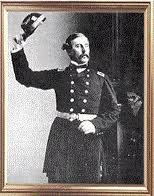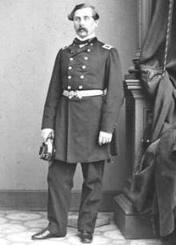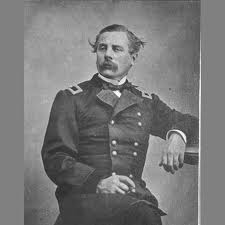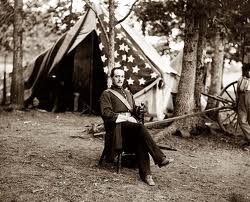 Meagher Irish Hero, was not only an established political operative, lawyer, newspaper editor and orator, but an inspiration to immigrants and a genuine New York Patriot. As the most famous leader of the Irish Brigade, Meagher Irish Hero, one of the Civil War’s most colorful generals, attempted to use his military experience as a springboard to high political office, but his career was cut short by the Irish immigrant’s untimely and mysterious death.
Meagher Irish Hero, was not only an established political operative, lawyer, newspaper editor and orator, but an inspiration to immigrants and a genuine New York Patriot. As the most famous leader of the Irish Brigade, Meagher Irish Hero, one of the Civil War’s most colorful generals, attempted to use his military experience as a springboard to high political office, but his career was cut short by the Irish immigrant’s untimely and mysterious death.
Thomas Francis Meagher, was born on August 3, 1823, in Waterford City, Ireland, to a wealthy family. As a young man, he attended a Jesuit school in County Kildare and later transferred to Stoneyhurst College in Lancashire, England, graduating in 1843. Meagher returned to Ireland to continue his studies further and become a lawyer. At the age of 23, he ventured into politics and due to gift of oratory he became known as “Meagher of the Sword”. As he and his “Young Ireland” party became more influential, his speeches were often quoted by admirers in Ireland. During the potato famine in 1848, Meagher and other members of his “Young Ireland” party took part in a rebellion, but due to a lack of arms and support, they were soon arrested and charged with “Treason against the Queen”.
Meagher was sentenced to be “hung, drawn and quartered” but the sentence was reduced to deportation for life to Van Diemans Land, an island off the coast of Australia. In 1849, Meagher was deported, but escaped in 1852 and after he arrived in New York, he became a United States Citizen, studied law for 3 years and in 1855 was admitted to the bar. In 1856 he started his own newspaper called “The Irish News” and in 1858 he had a report published in Harper’s Weekly about an expedition he had just made to Central America. All this publicity made him a leader of the Irish community in New York and when the Civil War began in 1861, Irishmen flocked to join the brigade that Meagher was recruiting.
 Originally the Irish Brigade consisted of three regiments from New York City, the 63rd, 69th and 88th New York. These units, although they drew heavily on the membership of the earlier 69th New York State Militia, were a separate category of troops known as “State Volunteers.” This meant that they served at the discretion of the federal government, not that of the states. On the other hand, they were still allowed to retain some of their individual character, and one way that they did this was through their distinctive battle flags.
Originally the Irish Brigade consisted of three regiments from New York City, the 63rd, 69th and 88th New York. These units, although they drew heavily on the membership of the earlier 69th New York State Militia, were a separate category of troops known as “State Volunteers.” This meant that they served at the discretion of the federal government, not that of the states. On the other hand, they were still allowed to retain some of their individual character, and one way that they did this was through their distinctive battle flags.
When the war broke out Meagher joined the 69th New York State Militia and later, due to his connections with President Lincoln, became a brigadier general and ultimately took command of the Irish Brigade. While in charge of this organization he led his troops during the Peninsula Campaign, Antietam Campaign and then Fredericksburg. At the latter two battles the brigade suffered horrendous casualties, eventually reduced to the point where the entire brigade could only field the number of men contained in a newly recruited regiment.
Perhaps the Irish Brigade’s greatest glory came at Antietam, where the brigade led a ferocious charge against Confederate riflemen entrenched in a sunken farm road that became infamous as “Bloody Lane.” General Meagher had his horse shot out from under him and critics spread the rumor that he had been drunk and toppled from his mount.
 At Fredericksburg, on December 13, 1862, the brigade made a series of charges against Confederate riflemen assembled behind a stone wall. Out of 1,200 Irish soldiers in the attack, approximately half were killed or wounded. The Irish Brigade suffered its largest losses at Fredericksburg. Meagher led 1,200 men into battle, and “two hundred and eighty men only appeared under arms to represent the Irish Brigade” the next morning. Meagher was also wounded in this battle when he was hit in the leg by a cannonball and spent the next four months recovering from his injuries.
At Fredericksburg, on December 13, 1862, the brigade made a series of charges against Confederate riflemen assembled behind a stone wall. Out of 1,200 Irish soldiers in the attack, approximately half were killed or wounded. The Irish Brigade suffered its largest losses at Fredericksburg. Meagher led 1,200 men into battle, and “two hundred and eighty men only appeared under arms to represent the Irish Brigade” the next morning. Meagher was also wounded in this battle when he was hit in the leg by a cannonball and spent the next four months recovering from his injuries.
Meagher then took charge of his command three days prior to Chancellorsville. After a limited engagement, Meagher resigned his commission on May 14, 1863, over the Army’s refusal to let him return to New York to raise reinforcements for his battered brigade. The brigade was 4,000 strong in mid May 1862, but by late May 1863 it had only a few hundred combat-ready men left.
Following Fredericksburg he was relieved as commander of the Irish Brigade and wishing to still serve, was sent west. Here he was placed in command of some 7,000 troops with orders to bring them east to join in the fighting there. The transfer ended up being such a failure that Meagher was totally relieved of command.
The Irish Brigade, with some of its wounded restored to active duty, was able to assemble approximately 600 men before the summer of 1863. At the Battle of Gettysburg the brigade again saw heavy action and sustained horrific casualties. The focal point of the Irish Brigade’s action at Gettysburg was in the area known as The Wheatfield.
By 1864 the Irish Brigade had lost so many men that the entire brigade had shrunk to the size of a single regiment. The U.S. Army absorbed it into other units.
 Meagher was rarely the one to turn down a drink. This led eventually to the rumors of Meagher having a drinking problem. During the battles he participated in, on more than one occasion, he fell from his horse. Some supporters provided the excuse that he suffered some sort of injury and this led to his accidents on horseback.
Meagher was rarely the one to turn down a drink. This led eventually to the rumors of Meagher having a drinking problem. During the battles he participated in, on more than one occasion, he fell from his horse. Some supporters provided the excuse that he suffered some sort of injury and this led to his accidents on horseback.
Meagher was reinstated on December 23, 1864 and he was assigned to duty in the Western Theater. He commanded the District of Etowah in the Department of the Cumberland until January 5, 1865. Then briefly commanded a provisional division within the Army of the Ohio until February 25 and finally resigned from the U.S. Army on May 15,1865.
Shortly after his resignation, President Andrew Johnson appointed Meagher to be the new secretary of the Montana Territory. Meagher arrived in Montana in September of 1865 and immediately found himself the acting governor of Montana. He was promptly branded as inept, accused of being a womanizer and a drunkard. For almost two years, Meagher cut a wide swath through Montana politics, alternately infuriating Democrats and Republicans alike. The furious opposition to Meagher forced him to organize cavalry troops to help enforce the rules in the territory. On July 1, 1867, Meagher left for Fort Benton with “a large amount of money” to purchase arms and ammunition for his cavalry enforcers. On arrival at Fort Benton he found that the supply ship carrying the arms was late in arriving and being extremely impatient, he decided to take a steamer down river to meet the shipment. Meagher was seen boarding the steamer but was never seen again nor was his body ever found. The large amount of money also vanished with him. He was officially reported as “having wandered on deck and drowned after falling overboard”. The incident that ended the life of the colorful Irishman has been shrouded in mystery ever since. Some people theorized that Meagher had been drinking and had accidentally fallen off the boat. Others thought he had committed suicide or that he had been murdered by his political enemies in the Montana Territory.
Whatever the circumstances of his tragic demise, Meagher was not only an Irish Hero and New York Patriot, but an outstanding example of the prospects of immigrants attaining the American Dream.
Bummer


The Peter Welsh letters are poetic, but I’d love to have his wife’s missives. She clearly did not buy into his patriotic gore.
Pat,
Thanks for the input, the “old student” needs to read the Welsh letters, have ordered the “Irish Green and Union Blue.” Trying to do as much research as possible on the common Irish participation in the Civil War. Have concentrated on the Western Theater for ever.
Bummer
The letters are essentially a two year running argument between Peter and his wife. We only have his letters, but since they apparently respond to arguments she is making, we can easily infer wha she said. Her arguments are piced by the fact that Peter enlisted without telling her.
“spiced”, not “piced”
Pat,
“Piced or Spiced” it’s all good. Looking forward to delivery of Peter’s correspondence.
Bummer
Meagher is one of those Civil War figures of whom I knew little more than his name until now. Sounds like he had a colorful career no matter how good or bad he was in battle. It’s even more amazing when you consider the prevalence of “No Irish Need Apply” signs of that day.
Louis,
Colorful to say the least. Don’t know if he was a good or bad commander, but suffice it to say that when he did lead, he led from the front. It should be said that he and his horses didn’t get along.
Bummer
04/30/13 Meagher has a very ‘mixed’ CW legacy. Based upon his role in the “Revolution of 1848” in IRE (UK), he got labeled by some politicians in NYC as a political “intiriguer” before the war. His ‘value’ to the AoP was largely known for very successful recruiting, morale building, equipping, and peerless support, some would say indulgence, of his brave soldiers but he was not a great battlefield brigade commander who was somewhat reckless and incurred horrendous losses amongst his five regiments. The Irish Brigade was not ‘officially’ established until Nov 1862 after the Battle of Antietam (Sept 1862). While the Irish Brigade was authorized earlier (1861), the Regts had not fully been organized, At Antietam, actually three Regts fought together (63rd NY; 69th NY; and 116th PA). Another ‘independent” non-Irish Regt (29th Mass) fought the day before at adjacent Smith mountain. When the Brigade was finally established (Nov 1862), the 28th Mass (Irish) Regt replaced the independent 29th MA Regt. Historical Irony: The “Irish Brigade” Monument at the Gettysburg, PA battlefield (gift of IRE) identifies the 29th but not the 28th MA Regt as an element of the Brigade, At the Battle of Fredericksburg, VA, The AOP (Irish Brigade) and the CSA forces (two Brigades under BG Maxcy Gregg (KIA) and BG Thomas Cobb) opposed each other at Marye’s heights. When the 24th GA INF Regt (Gregg) saw that the Irish 69th’s Emerald Battle flag, they refused to fire on their fellow Irishmen. So did the “Jasper Greens” , an independent Irish INF Company (Cobb), from Savannah, GA. Rebel brigade commanders were appalled and called in reserves to take the Irish Brigade’s assault
Primary Source: “Irish Green and Union Blue”, The Civil War letters of Peter Welsh, Color Sergeant, 28th Regiment Mass Vols, NY, Fordham Univ Press (1986)
John,
Thanks for filling in the “Irish Brigade” details, especially from the letters of Peter Welsh, “Irish Green and Blue”. The “old guy” needs to spend more time on the Eastern Theater, been stuck in the Western for most of 50 years. You offer the knowledge to fill in many of the obvious holes. Thanks for following and adding “the rest of the story!” Meagher seemed to be his own worst enemy, brilliance, a large dose of ego and maybe a severe drinking problem. Hate to judge after almost 150 years and speak disparagingly of the dead, but if he crossed Sherman early in the War, his career was probably sealed.
Bummer